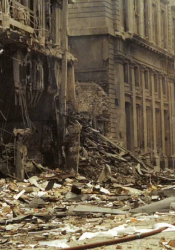IRA Bombing of Bishopsgate
On April 24, 1993, the Irish Republican Army detonated a car bomb outside of 99 Bishopsgate that caused massive damage to London’s financial district, injuring 44 and killing one (“Bishopsgate Bomb”). According to witnesses, most of the windows from nearby skyscrapers were shattered, spreading glass and debris throughout the streets. The explosion also created a large crater near the Hong Kong and Shanghai Banking Corporation building (Schmidt). Additionally, the medieval St. Ethelburga’s church and the nearby Liverpool Street station were reduced to rubble. The explosion came a year after another IRA bombing destroyed the nearby Baltic Exchange, while the Warrington IRA bomb killed three children just a month prior (“BBC on This Day”).
About an hour prior to the explosion, the police received a coded telephone call from the IRA warning about the bomb. Despite some evacuations, a significant number of people were still affected by the blast, often being knocked unconscious (Schmidt). In response to the Bishopsgate explosion and other IRA bombings, the City of London police created a “ring of steel” around the financial district, creating roadblocks and other security measures meant to prevent terrorism (“BBC on This Day”). Many roads into the City were closed or made exit-only, and police monitored routes into the area 24 hours a day (“Bishopsgate Bomb”). Such checkpoints, however, were phased out following a ceasefire with the IRA in 1994 (“New ‘Ring of Steel’”). As a final note, over 2,000 rubbish bins were also phased out following the attack as an added security measure. Rubbish bin totals for the region remain below 100 (“Bishopsgate Gets Bins”).
As Bishopsgate serves primarily as a financial district, those injured by the blast were predominantly office workers, security, and tourists rather than permanent residents (Schmidt). A security guard at the Hong Kong and Shanghai Banking Corporation building was knocked unconscious by the blast, for instance. In the Moorgate Underground station, commuters and other passengers likewise felt the blast—though it caused primarily panic rather than any injury (Schmidt). In total, the IRA bombing of Bishopsgate cost £350 million in repairs, and the “ring of steel” created in response served as a model for later security measures by the City of London police following the 2016 truck attack in Berlin (“BBC on This Day”; “New ‘Ring of Steel’”).
“BBC on This Day | 24 April | 1993: Ira Bomb Devastates City of London.” BBC News, BBC,
24 Apr. 1993, http://news.bbc.co.uk/onthisday/hi/dates/stories/april/24/newsid_2523000/2523345.stm. Accessed 17 Apr. 2023.
“Bishopsgate Bomb: Photos Issued on 25th Anniversary.” BBC News, BBC, 24 Apr. 2018,
https://www.bbc.com/news/uk-england-london-43878479. Accessed 17 Apr. 2023.
“Bishopsgate Gets Bins Back 20 Years After IRA explosion.” BBC News, BBC, 14 Aug. 2023.
https://www.bbc.com/news/uk-england-london-23695239. Accessed 17 Apr. 2023.
Image of Aftermath of 1993 Bishopsgate Bombing. BBC News, 24 Apr. 2018.
https://ichef.bbci.co.uk/news/976/cpsprodpb/7FC7/production/_101011723_29.png.webp. Accessed 17 Apr. 2023.
“New 'Ring of Steel' Planned for London Square Mile.” BBC News, BBC, 24 Dec. 2016,
https://www.bbc.com/news/uk-england-london-38418877. Accessed 17 Apr. 2023.
Schmidt, William E. “1 Dead, 40 Hurt as a Blast Rips Central London.” The New York Times,
The New York Times, 25 Apr. 1993, https://www.nytimes.com/1993/04/25/world/1-dead-40-hurt-as-a-blast-rips-central-london.html. Accessed 17 Apr. 2023.

